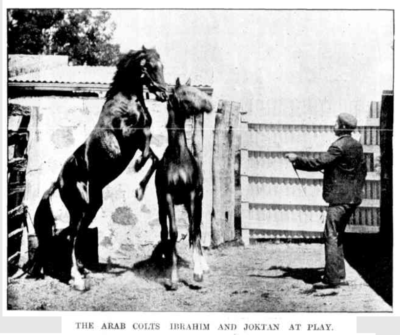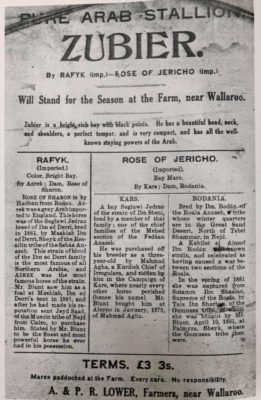Arabians in early Australia
Caption: The Arab colts Ibrahim and Joktan at play.
For a change of pace, here’s a picture of some colts from Sir James Boucaut’s Quambi Spring Stud of Australia. This was published February 20th, 1904 in The Adelaide Chronicle newpaper, the online archive of which can be found here. There is an article, entitled “THE QUAMBI STUD FARM,” which you can also read in addition to looking at the pictures.
My inquiries into the RAFYK sons ZUBEIR AND SULEIMAN had revealed that Zubeir, at the very least, was used as a breeding stallion. The above colts are actually some of Zubeir’s offspring, the colt IBRAHIM being foaled out of the mare SHERIFA (Rafyk x Dahna) on August 12th, 1902, whereas the colt JOKTAN was foaled out of the mare LABADAH (Mahboub x Sherifa) October 6th, 1902.
Both colts were sold to Mr. T. H. Pearce, of the Katherine, Northern Territory and the owner of the Willaroo Station, who in Boucaut’s book was reported as having wired the safe arrival of Ibrahim and Joktan at the station in June of 1904, saying: “They give every satisfaction, and I am delighted with them.”
Another accounting of these two stallions was reported by the Territory Government Resident (also known as the Administrator of the Northern Territory) in 1904 that Mr. Pearce had purchased from “Sir J P Boucat two desert Arab stallions, and he informs me that they are growing into nice horses – they are quiet and docile, yet full of fire. I think the cross he has decided on will result in a useful horse.”
Mr. Pearce’s original intention was to use Ibrahim and Joktan to breed horses for the Indian Remount market. By contrast, Boucaut’s stud serviced a growing desire for the use of Arabians in the Station herds as a contrast the use of English-bred thoroughbreds, which were bred for speed rather than strength and endurance and against whom there were concerns that these horses were decreasing the quality of their horses. Whether or not this is true (and there is much evidence to suggest that it was not!), many Thoroughbred sires were selected for their appearances and it was not unusual to have to deal with what turned out to be nasty-tempered horses. There is a notable case of the horses from Charter’s Towers post-WWI being full of unruly horses sired by a Thoroughbred or Thoroughbred-cross stallion that was nicknamed The Snake. This should hopefully provide a bit of context for those of you know enjoyed the film, The Man from Snowy River. Which is why Boucaut got to work with breeding as many Arabian horses as he could at his farm – as many Arabians as could be bred were sent out to the large inland cattle properties as station sires, according to the noted scholar Coralie Gordon.
The Arabian was, of course, but one part of the equation that went into breeding the reknowned Station horses of Australia, the collection of which gained fame as exceptional remounts during WWI and served as the foundation of the modern Australian Stock Horse and the Waler.

